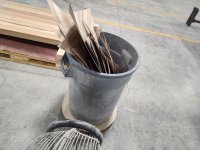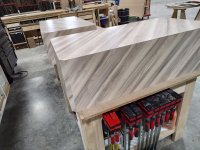- Joined
- Oct 16, 2015
- Messages
- 5,559
I spent most of the afternoon Friday just working on parts, no assembly yet. I had finished up some more of the pieces for another of those gas stations with the diagonal grain laminate. Now I am down to the last few bits. The rolling platforms/carts are always last because there is no "install" to them. They just sit on the finished floor at the very end of the job.
After building the frames and laminating the panels for the outside of them, I started the mitering for the clipped corners and ran out of day. All I got cut were some of the corner caps, still need 8 more, since there are 4 units to build. I lined up the cut pieces and wondered how well they would actually fit together. A couple of strips of blue tape and this was the result. Pretty darn good fit.
They will end up looking similar to the last pic on Monday, except 2' x 4' boxes with wheels.
After building the frames and laminating the panels for the outside of them, I started the mitering for the clipped corners and ran out of day. All I got cut were some of the corner caps, still need 8 more, since there are 4 units to build. I lined up the cut pieces and wondered how well they would actually fit together. A couple of strips of blue tape and this was the result. Pretty darn good fit.
They will end up looking similar to the last pic on Monday, except 2' x 4' boxes with wheels.

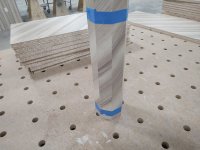
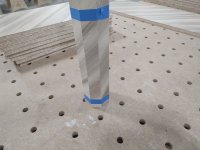
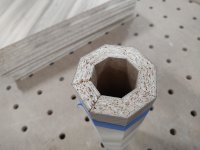
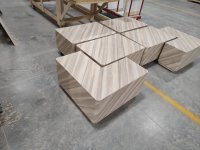
![20180725_065154[839].jpg](/data/attachments/71/71774-78b07957a6467f26db639ea87ccdbf4e.jpg?hash=9KzjCjj5j4)
![20180723_063651[840].jpg](/data/attachments/71/71773-2d13714fb9bbbbfeb584da6e996841ae.jpg?hash=4Ry8Atjs5h)
![20180723_063713[836].jpg](/data/attachments/71/71770-a8b821b1a94c2cba1959ba61c3f68596.jpg?hash=dX3KENVUwL)
![20180723_063654[838].jpg](/data/attachments/71/71768-f0bd1df901da8a8e2159587933082bf8.jpg?hash=FfmNVWLKyU)
